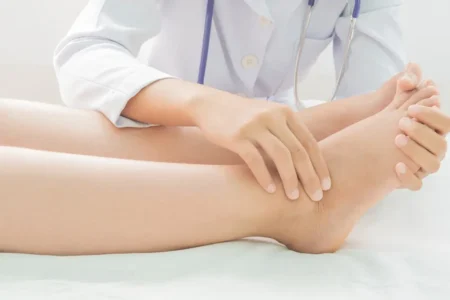the definition :
Tissue swelling due to the accumulation of a fluid rich in proteins, It normally drains through the body’s lymphatic system. This condition usually affects the arms or legs. But it may affect the chest wall, abdomen, neck, or genitals.
Lymph nodes are an important part of the lymphatic system. Lymph swelling may be caused by cancer treatments that require removal of, or damage to, lymph nodes. It may also result from any kind of problem that obstructs the drainage of lymph fluid.
Symptoms of lymphedema
partial or total swelling of an arm or leg, Including fingers or toes
A feeling of heaviness or tightness
Restricted range of motion
Frequent infections
Skin hardness and thickening (fibrosis)
Symptoms may range from mild to severe. Lymphedema from cancer treatment may not occur until months or years after treatment.
Causes of lymphedema
– Cancer. If cancer cells block lymph vessels, Lymphedema may occur. for example, It is possible for a lymph node or vessel to become enlarged enough to block the flow of lymph fluid.
Radiotherapy for cancer. Radiation may cause vasculitis.
– oncological surgery, Lymph nodes are often removed to see how far the cancer has spread. But, This does not always lead to lymphedema.
– parasites in developing countries, particularly in the tropics, It turns out that the most common cause of lymphedema is infection with a nematode that blocks the lymph nodes.
– produce lymphedema, less commonly, From genetic conditions in which the lymphatic system does not develop normally.
Lymphedema treatment
Surgical treatment of fibroid
Lymph node transplantation. Lymph nodes are taken from a different part of the body. It is then connected to a network of lymphatic vessels in the affected limb. Forestry works well for many people with advanced lymphedema. It can reduce the amount of stress required on the limbs.
New drainage pathways. Another possible treatment option for lymphedema is this procedure in which new connections are made between the lymphatic network and blood vessels. and then, Excess lymphatic fluid is removed from the limb through blood vessels.
Excision of fibrous tissue. In cases of acute lymphedema, Fibrosis and hardening of the soft tissues in the extremities. Removing some of these hardened tissues, usually through liposuction, can improve the functioning of the limbs. In very severe cases, Hardened tissue and skin can be removed with a scalpel.
Pharmacological treatment of lymphedema
Lymphedema greatly increases the risk of skin infections (cellulitis). Therefore, the doctor may prescribe antibiotics so that they are on hand and that you can take them as soon as symptoms appear.
Natural treatment for lymphedema
– Therapeutic massage This therapeutic massage is performed by a physiotherapist in several sessions, Where this type of treatment needs a certain period of time to stimulate lymphatic drainage, This is due to the therapist making light and regular movements to get rid of the accumulation of lymphatic fluid in the affected arm.
It is worth noting that there are some contraindications to therapeutic massage. Such as: the presence of inflammation in the skin tissue of the affected arm, The patient suffers from blood clots or inflammation of the lymph nodes.
Manual lymph drainage: In this massage-like technique, the physiotherapist applies very light pressure to move the fluid trapped in the swollen limb toward an area containing healthy lymphatic vessels. Patients should avoid manually draining lymph fluid if they have skin infections, blood clots, or active cancer in the affected limb.
Compression bandages: Using a low-stretch bandage to wrap the affected limb can encourage lymph fluid to flow back into the trunk.
Compression garments: Tight rubber sleeves or long stockings can apply pressure to the arm or leg to stimulate lymphatic fluid drainage. These garments often require a doctor’s prescription to ensure the proper amount of pressure is applied to the extremities. You may need to have a specialist take your measurements to ensure a proper fit.
Lymphatic drainage device: In this way, a sleeve worn on the affected arm or leg is connected to a pump that inflates the sleeve intermittently. This puts pressure on the limb and moves lymph fluid away from the fingers or toes.
Laser use

